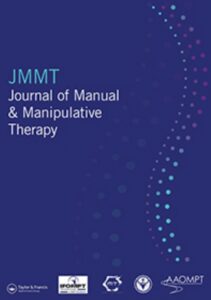Publications

Reference values for muscle stiffness and asymmetry using myotonometry: a pilot study
Authors: Seth Spicer 1, Adam Friedman 1, Dan Yacubovich 1, Alexander King 1, 2
Affiliations:
- Rowan-Virtua School of Osteopathic Medicine, Sewell, NJ, USA
- Rowan Medicine, Rowan-Virtua NeuromusculoSkeletal Institute, Sewell, NJ, USA
Journal: Journal of Manual & Manipulative Therapy - November 2025 (DOI: 10.1080/10669817.2025.2589162)
-
Field & Applications:
- Normatives
- Musculoskeletal health
- Muscle symmetry
Objectives: To establish preliminary reference values for resting muscle stiffness and bilateral asymmetry in healthy young adults, and to explore associations with sex, age, BMI, and weekly exercise.
Design: Cross-sectional observational pilot study.
Setting: Osteopathic medical school facilities.
Participants: Twenty-six healthy individuals aged 18–29 years, 19 males and 7 females.
Main Outcome Measures: Resting muscle stiffness and left–right asymmetry across seven muscle groups, measured using the MyotonPRO. Associations with sex, age, BMI, and weekly exercise were analyzed.
Results: Sex was the only significant predictor of muscle stiffness overall, model F(4,21) = 2.88, p = 0.048, R2 = 0.355, with higher stiffness in males, coefficient 44.6 N/m, p = 0.007. Global stiffness was greater in males than females, 236.2 ± 30.8 vs 196.2 ± 23.7 N/m, p = 0.017, Cohen d = 1.13. Age, BMI, and weekly exercise were not significant predictors, p = 0.388, 0.077, and 0.790, respectively. Sex-specific reference intervals, central 95%, for stiffness and asymmetry were derived for each muscle. Average bilateral asymmetry was small, about 10% to 14%, consistent with physiologic side-to-side differences.
Conclusions: This study demonstrates the feasibility of defining reference ranges for muscle stiffness and asymmetry using the MyotonPRO. These reference values may support musculoskeletal assessments in osteopathic and sports medicine and may help identify clinically meaningful deviations in tissue properties. Larger and more diverse cohorts are needed to refine intervals and to link stiffness to changes in patient outcomes.
Keywords: myotonometry, muscle stiffness, sex differences, musculoskeletal assessment
This pilot study is the first to establish preliminary normative ranges for muscle stiffness and asymmetry across multiple muscle groups in healthy young adults using the MyotonPRO. By providing standardized values in N/m, this work introduces a practical framework for quantifying tissue properties that have historically been difficult to measure with precision. These findings support the feasibility of integrating myotonometry into clinical practice to detect deviations from normative tensegrity. Importantly, the ability to define ‘normal’ stiffness and asymmetry offers a foundation for identifying clinically meaningful deviations associated with pain, dysfunction, or injury. This shifts assessment from subjective palpation toward objective, quantifiable metrics that can guide diagnosis, track treatment effects, and inform individualized rehabilitation strategies.
Looking forward, larger and more diverse cohorts are needed to refine these reference intervals and to establish minimal clinically important differences (MCID) that link stiffness changes with patient outcomes. Ultimately, the integration of normative myotonometric data into musculoskeletal and osteopathic medicine may transform how we evaluate tensegrity in the human body, opening a path toward more precise, mechanistically informed diagnosis and treatment of neuromusculoskeletal disorders.


